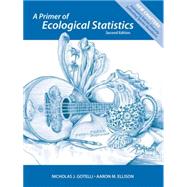A Primer of Ecological Statistics

A Primer of Ecological Statistics
- ISBN 13:
9781605350646
- ISBN 10:
1605350648
- Edition: 2nd
- Format: Paperback
- Copyright: 11/15/2012
- Publisher: Sinauer Associates is an imprint of Oxford University Press
.svg) Rent
From $74.12
Rent
From $74.12
List Price $138.65 Save
| TERM | PRICE | DUE |
|---|---|---|



List Price $138.65 Save $1.38
Usually Ships in 3-5 Business Days
We Buy This Book Back!
Free Shipping On Every Order
Note: Supplemental materials are not guaranteed with Rental or Used book purchases.
Extend or Purchase Your Rental at Any Time
Need to keep your rental past your due date? At any time before your due date you can extend or purchase your rental through your account.
Summary
The book is divided into four parts. Part I discusses the fundamentals of probability and statistical thinking. It introduces the logic and language of probability (Chapter 1), explains common statistical distributions used in ecology (Chapter 2) and important measures of central tendency and spread (Chapter 3), explains P-values, hypothesis testing, and statistical errors (Chapter 4), and introduces frequentist, Bayesian, and Monte Carlo methods of analysis (Chapter 5).
Part II discusses how to successfully design and execute field experiments and sampling studies. Topics include design strategies (Chapter 6), a "bestiary" of experimental designs (Chapter 7), and transformations and data management (Chapter 8).
Part III discusses specific analyses, and covers the material that is the main core of most statistics texts. Topics include regression (Chapter 9), analysis of variance (Chapter 10), categorical data analysis (Chapter 11), and multivariate analysis (Chapter 12).
Part IV--new to this edition--discusses two central topics in estimating important ecological metrics. Topics include quantification of biological diversity (Chapter 13) and estimating occupancy, detection probability, and population sizes from marked and unmarked populations (Chapter 14).
The book includes a comprehensive glossary, a mathematical appendix on matrix algebra, and extensively annotated tables and figures. Footnotes introduce advanced and ancillary material: some are purely historical, others cover mathematical/statistical proofs or details, and still others address current topics in the ecological literature.
For Students
Data files and code used for some of the examples are available on the companion website.
For Instructors
Instructor's Resource Library
This resource includes all figures (line-art illustrations and photographs) and tables from the textbook, provided as both high- and low-resolution JPEGs. All have been formatted and optimized for excellent projection quality. Also included are ready-to-use PowerPoint slides of all figures and tables.






